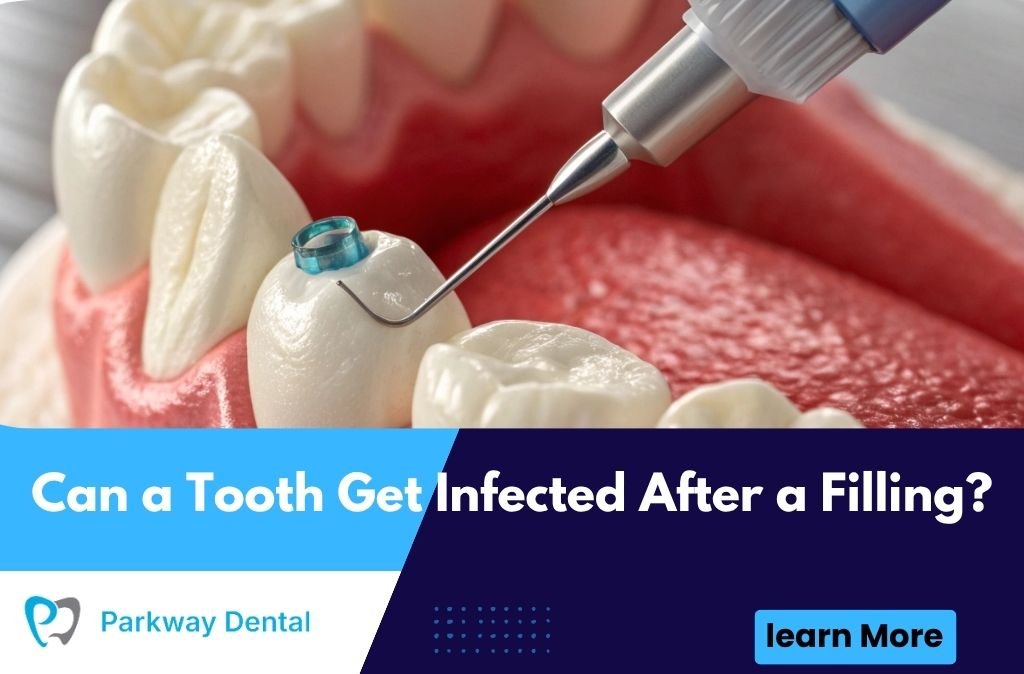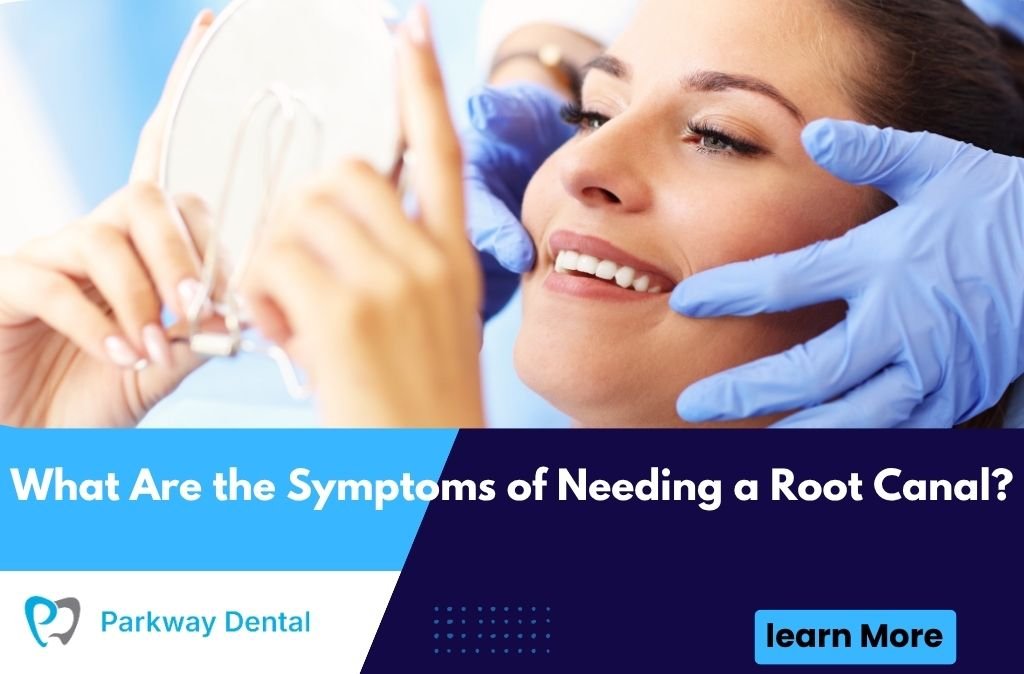Dental fillings are a routine and effective way to restore teeth damaged by decay or minor fractures. They protect the tooth from further decay and restore normal function. However, some patients experience pain, sensitivity, or swelling even after a filling — raising a common concern: can a tooth get infected after a filling?
The short answer is yes — though fillings are designed to stop decay, a tooth can still develop an infection if bacteria find a way inside or if the damage extends deeper than expected. This article explains why infections occur, what signs to look for, how they’re treated, and how to prevent complications after a dental filling.
Table of Contents
Understanding How Dental Fillings Work
Dental fillings are used to repair teeth affected by cavities or minor fractures. During the procedure, the dentist removes decayed tissue, cleans the cavity, and fills the space with materials such as composite resin, amalgam, or porcelain. The filling seals the tooth, preventing bacteria from re-entering.
In most cases, fillings last for many years. However, improper sealing, hidden decay, or post-treatment issues can occasionally lead to infection inside the tooth or surrounding gums.
Why a Tooth May Get Infected After a Filling
Even though a filling seals the surface, certain underlying or procedural factors can make an infection possible.
Deep Decay or Missed Bacteria
If the decay extends too close to the pulp (the tooth’s soft inner tissue containing nerves and blood vessels), bacteria can survive inside even after the filling. Over time, this can lead to pulpitis, an inflammation of the pulp, which may progress into a full infection requiring root canal therapy.
Cracked or Leaking Fillings
Over time, fillings can crack or separate from the tooth’s edges, creating gaps where bacteria enter. These leaky fillings allow food particles and bacteria to invade, eventually infecting the tooth beneath.
Incomplete Removal of Decay
Sometimes, microscopic decay remains beneath the filling material, especially if it’s difficult to detect. These bacteria can continue to multiply, causing new decay and infection under the restoration.
Post-Filling Nerve Irritation
The dental pulp can become irritated after deep fillings. If inflammation persists, it can compromise the pulp’s blood supply, making it more vulnerable to bacterial infection.
Poor Oral Hygiene After the Procedure
Even after a successful filling, neglecting proper brushing and flossing allows plaque and bacteria to accumulate around the tooth. This can cause gum inflammation or infection in neighboring teeth.
Signs and Symptoms of an Infected Tooth After a Filling
Early detection is key to preventing complications. If you’ve recently had a filling, watch for these warning signs:
- Persistent or throbbing tooth pain
- Sensitivity to hot or cold that doesn’t fade
- Swelling in the gums or face
- Bad taste or foul odor in the mouth
- Pain when biting or chewing
- Redness or pus around the affected area
- Fever or general discomfort
These symptoms suggest that bacteria may have reached the tooth pulp or surrounding tissue, requiring prompt dental attention.
Diagnosing a Tooth Infection After a Filling
When you visit your dentist, they’ll perform a detailed evaluation to pinpoint the source of infection.
Clinical Examination
Your dentist will check for visible decay, cracks in the filling, gum swelling, or tenderness when applying pressure to the tooth.
Dental X-Rays
Digital X-rays reveal hidden decay, deep infections, or abscess formation near the tooth root. They also help determine if the infection has spread to the surrounding bone.
Pulp Vitality Testing
In some cases, your dentist may test the tooth’s nerve response to assess whether the pulp is still alive or infected.
Treatment Options for an Infected Tooth After a Filling
If an infection is detected early, the dentist can often save the tooth through targeted treatment. The exact method depends on the severity and extent of infection.
Antibiotic Therapy
For mild infections or early inflammation, antibiotics can help control bacterial spread. However, antibiotics alone cannot cure infections within the tooth; they only provide temporary relief until further treatment is completed.
Root Canal Treatment
If bacteria reach the pulp, root canal therapy becomes necessary. The dentist removes the infected pulp, cleans and disinfects the canals, and seals the tooth with a filling or crown. This eliminates infection while preserving the natural tooth structure.
Filling Replacement
If the infection is caused by a damaged or leaky filling, your dentist will remove it, clean the cavity thoroughly, and place a new filling. Composite fillings are preferred for their tight seal and natural appearance.
Tooth Extraction (Last Resort)
In severe cases where the infection has spread too far or caused bone loss, extraction may be necessary. The missing tooth can then be replaced with an implant or bridge.
Recovery and Aftercare
Following treatment, proper aftercare helps ensure successful healing and prevent reinfection.
Pain Management
Mild discomfort is normal for a few days after treatment. Over-the-counter pain relievers like ibuprofen can help ease inflammation and soreness.
Oral Hygiene
Brush gently twice a day and floss carefully around the treated tooth. Use a soft-bristled toothbrush and non-alcoholic mouthwash to prevent irritation.
Follow-Up Visits
Your dentist will schedule follow-up appointments to monitor healing and ensure the infection has fully resolved.
Preventing Tooth Infections After Fillings
While some factors are beyond your control, good dental care practices can significantly reduce the risk of post-filling infection.
Maintain Good Oral Hygiene
Brush twice daily using fluoride toothpaste and floss once daily to remove food particles that can cause new decay.
Choose the Right Filling Material
Composite fillings bond more securely to the tooth and reduce the risk of leakage compared to metal amalgams.
Regular Dental Checkups
Routine visits every six months allow early detection of cracked or worn-out fillings, preventing infection before it starts.
Avoid Grinding or Clenching
Chronic teeth grinding (bruxism) can weaken or crack fillings. Wearing a custom night guard can help protect your restorations.
Watch Your Diet
Limit sugary or acidic foods that promote bacterial growth and enamel erosion. Stay hydrated to keep your mouth naturally cleansed.
Long-Term Risks of Ignoring an Infected Tooth
If left untreated, a tooth infection can spread beyond the mouth, leading to serious health problems such as:
- Dental abscesses (pus-filled pockets)
- Bone infection (osteomyelitis)
- Sinus infections (if the upper jaw is affected)
- Systemic infection or sepsis in severe cases
Early dental care not only saves your tooth but also protects your overall health.
When to See a Dentist
Seek immediate dental attention if you experience:
- Persistent pain that lasts more than 48 hours after a filling
- Swelling around the face or jaw
- Visible pus or bad taste in the mouth
- Sensitivity that worsens instead of improving
Prompt care can prevent a simple infection from turning into a complex dental emergency.
Conclusion
While dental fillings are effective for treating cavities, infections can occasionally occur if bacteria remain inside the tooth or if the filling becomes damaged. Ignoring the signs of infection can lead to pain, abscesses, or even tooth loss.
Regular checkups and early intervention can save your tooth and prevent further complications. If you experience pain, swelling, or sensitivity after a filling, visit a trusted Dentist in West Roxbury, MA for expert evaluation and treatment.
FAQs
Can a tooth infection happen right after a filling?
Yes. If bacteria remain inside the tooth or if the pulp becomes irritated during the procedure, an infection can develop shortly after treatment.
How do I know if my filling is infected?
Persistent pain, swelling, bad taste, and sensitivity to temperature changes are common warning signs.
How long should pain last after a filling?
Mild sensitivity may last a few days, but severe pain beyond a week may indicate infection.
Can antibiotics alone fix an infected tooth?
No. Antibiotics control infection temporarily but do not eliminate bacteria inside the tooth. A root canal or replacement filling is usually needed.
Can a tooth get re-infected after a root canal?
Yes, if bacteria re-enter through cracks or poor sealing, though this is uncommon with proper care.
How can I prevent infection after getting a filling?
Maintain good oral hygiene, avoid chewing on hard objects, and visit your dentist regularly to check the filling’s integrity.
Can an infected tooth heal on its own?
No. Once a tooth is infected, professional treatment is required to remove bacteria and restore oral health.
What happens if I ignore an infected tooth?
Ignoring an infection can lead to abscesses, bone loss, or even systemic health problems if bacteria spread through the bloodstream.
How often should fillings be checked?
Fillings should be examined during your routine dental visits every six months to detect cracks or wear early.
Is it normal to feel pressure after a filling?
Slight pressure is normal for a few days, but persistent pain may indicate a high bite or infection that needs adjustment.





